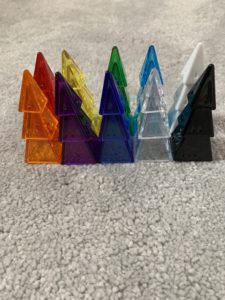Recently I became obsessed with the Pyramid Arcade set, made by Looney Labs. At the end of the instruction manual (giving you rules for 22 games you can play) is a set of three challenges, titled “Glotz Challenges”.
The way Glotz Challenges work, is that they give you a base for a new game for the Arcade’s pyramidal playing pieces, for example Glotz Challenge #3 is “make a game using only the black & white larges & mediums”.
I haven’t done any of them yet, but I have made a different Glotz (I should probably explain that Glotz is the name for a pyramid game that isn’t finished yet). The Glotz I am working on is inspired by Synapse-ICE, another pyramidal game that has been finished enough to get a name.
Before I start writing about the rules, I should probably explain the pyramids too. They come in three sizes (small, medium, large) and ten colours: the Rainbow group (red, yellow, green, light blue and white) and the Xeno group (orange, purple, dark blue, transparent and black). You can also stack them on top of each other as they are missing the square side, only retaining the triangles, and they are completely hollow. The mediums fit snugly inside the larges and the smalls fit snugly inside the mediums, which makes for easy storage.

Everything’s better with a picture. Mostly.
Along with the pyramidal game-pieces, there are lots of other things, for example there is a 5 x 5 board that fits large pyramids in its squares perfectly; and a set of six 3 x 3 boards with arrows all over the place.
The particular Glotz I am making uses 3 pyramids of two colours, plus six other pyramids and it doesn’t matter what their colours are because they’re only for markers. On top of that it uses all six 3 x 3 boards, although it doesn’t utilise the arrows. It might as well just be a chessboard.
To play, first you pick colours and get a trio (a small, a medium and a large) of each. Then you arrange all six 3 x 3 (they’re called Looney Ludo boards, by the way) boards into a 6 x 9 rectangle, each of the two players picking a 6-long side to play from. Finally, you get two marker trios, although these are optional.
After that, you each place the markers at the bottom-right hand corners of the board, in the missing squares at your zeroth row. From there, you arrange them so that the small is in the far right, then medium, then large, which is almost at the middle. Next, you place 3 more pieces (your pieces now instead of the markers). They go in the same place as the markers of the same size, but in row 1. Lay them down so that their tips point towards the other player’s edge of the board.

After this, you actually get to start playing.
On your turn, there are two things you can do – or, more accurately, MUST DO – the move isn’t legal if you don’t.
MOVE:
At the start of your turn, move each of your pieces in the direction they are pointing by spaces less than or equal to their pip count. (Larges have a pip count of 3, mediums 2, and smalls 1). If a piece lands on another piece, return the other piece to its starting position. DO NOT CHANGE ITS ORIENTATION! If a piece moves off the edge, do the same thing as if it had been landed on.
AIM:
Next, aim all three pieces. You can aim them horizontally, vertically, or even diagonally. This decides which direction your piece moves THE NEXT TURN – which means that your opponent can then aim their piece that way in order to capture you on their next turn.
You win the game by starting your turn with a piece on the opponent’s end of the board.

Recent Comments